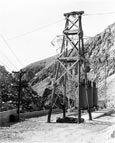 Barcode:
Barcode:1000320
Section of Adams Main Power Plant Subjects:
Hills
Electrical Apparatus
Power Lines
Collection: Bledsoe Collection 1908-1933
 Barcode:
Barcode:1000320 |
Title: Owens Valley Power Plants and Owens River Gorge
Description: Section of Adams Main Power Plant Subjects: Hills Electrical Apparatus Power Lines Collection: Bledsoe Collection 1908-1933 |
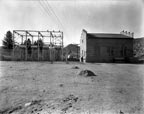 Barcode:
Barcode:1000473 |
Title: Owens Valley Power Plants
Description: Construction work on Big Pine Power Plant Subjects: Buildings Electrical Apparatus Power Lines Collection: Bledsoe Collection 1908-1933 |
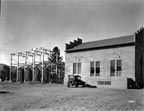 Barcode:
Barcode:1000478 |
Title: Owens Valley Power Plants
Description: Big Pine Power Plant 3 September, 1925 – “This is an ideal location for the Upper Plant; right over there we can located the intake for Plant No. 2 which will be farther down the canyon and that will locate Plant No. 3 in the delta just below the mouth of the canyon.” They were talking about the proper development of Big Pine Creek. The time was the summer of 1911. They were camped at the Forks of Big Pine Creek on the steep eastern slopes of the High Sierras. Above them towered the Sierras peaks 14,000 feet high – just below the crests were the snow and ice packs that give this section its renown for everlasting glaciers and constant water flow. The vision which prompted their decision was no doubt fathered by the realization that there was a close relationship between those towering peaks, the valley below, and the City of the Angels, 275 miles to the southward. Their vision included not only the proper development of power but the maximum use of the waters of the stream on the farms below; and their constant efforts and negotiations finally resulted in an agreement between the City and the Big Bear Water Users’ Association. An agreement of mutual benefit. The City was given the right to store water, provided it built the dams, and a schedule of water flow for each month was agreed upon. Built Dam at Lake No. 3 During the summer of 1921 a dam was partly built at Lake No. 2 and certain required storage thereby provided. The portion of the road built this summer of 1925, during the construction of Big Pine No. 3, looks forward to the ultimate raising of the level of the lakes and at the same time make that wonderful country accessible to the motorist. Big Pine No. 3 is now a reality. The mountains and the City have come closer together as a result of the completion of this project. This hydro-electric power is now flowing to the homes, farms and commercial centers of Owens Valley, where it renders a t cheap rates a service that is indispensable. More than that, – this power is adding in a big way to the water conservation and water development of Owens Valley directly – and the City of Los Angeles indirectly. It is the largest of six power plants on the 200-mile electric system which the City of Los Angeles owns and operates in Owens Valley. It is of especial interest that just at the time the plant was nearing completion, Mother Nature, through the vagaries of some record breaking storms, seriously crippled the Southern Sierras Power Company’s equipment that supplies some large chemical industries in the Valley, and through temporary connections Big Pine No. 3 Power Plant was able to step into the threatened power shortage and tide the Power Company over until repairs could be made. Big Pine No. 3 Power Plant is equipped with a 4,000-horsepower Pelton Water Wheel and a 4,000 K.V.A General Electric Generator which feeds into the 33,000-volt valley electric system of the Water Department through an outdoor step-up transformer station. Every possible provision has been made for the safety of men and equipment. In this power plant, whose intake is nearly a mile and a half above sea level, lightning is a nightly and almost daily visitor. The possibility of damage or interruption from this source was given special thought by the installation of the newest type of Auto Valve Lightning Arresters of the outdoor type. As much of the equipment as possible was installed outdoors and presents a pleasing part of the entire power plant setting. The building is of simple yet attractive design, reinforced concrete and fireproof in its construction, and withal it reflects credit to that first conception of location as well as to the more recent details of its construction. From the diversion dam or intake on the creek far up in the canyon, through the fish trap and the long pre-cast concrete flow line, to the steel penstock where the water shoots down more than 1,200 feet to the Power Plant, one can see every kind of difficult construction problem that can be imagined. This more then two miles of flow line and penstock was carved out of the steep mountain side under extreme difficulties. Careful preparation of construction equipment and the necessary provisions for making repairs or alterations in the field are largely responsible for the excellent showing made in completing the entire construction program within the scheduled time estimated. Too much credit cannot be given to the field forces for combating the various and sundry difficulties which are always present upon construction work. In this case, it was a race against time with the base of supplies 275 miles away and the fact added to the individual responsibilities of the men on the job. It is also to their credit that much of the work was done for less money than estimated and in some instances represented large savings over a contractor’s bid for doing the same work. At times, more than 200 men were employed, and the health of the various camps was 100 per cent, which speaks well for the cooks and the camp supervision. In carrying on the construction activities, every opportunity was given for the employment of Owens Valley residents and the few who went up from the city of Los Angeles were outspoken in their commendation of the interest displayed and the cordial treatment they received from their newly made friends in the Big Pine section. Many miles of excellent roads were built by the Department before the actual power plant construction could be started. These roads are already carrying a constantly increasing travel of autos into the glacier country at the head of Big Pine Creek. Big trees, waterfalls, beautiful lakes and permanent glaciers offer opportunity for fishing and sight-seeing which is unsurpassed in the West. The time is sure to come when this magnificent mountain country will be on the regular schedule of the traveling and camping public and when it does come, the Department of Water and Power will be given due credit for the constructive vision of its engineers in conserving and utilizing to best advantage so large a part of the natural resources on the Eastern Slope of the Sierra Nevada Mountains. Millions upon million of dollars is being spent in constructive activities in Owens Valley by the City of Los Angeles. The program of development is but started. “Rome was not built in a day.” The West was not won in a year nor a generation. As time goes by, and the far seeing vision of our leaders becomes reality, as has Big Pine No. 3, this southwest empire, from the High Sierras to the Pacific, will be one and the same family in thought, purpose and action. Subjects: Buildings Automobiles Electrical Apparatus Collection: Bledsoe Collection 1908-1933 |
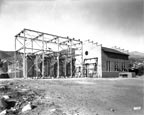 Barcode:
Barcode:1000479 |
Title: Owens Valley Power Plants
Description: Big Pine Power Plant 3 September, 1925 – “This is an ideal location for the Upper Plant; right over there we can located the intake for Plant No. 2 which will be farther down the canyon and that will locate Plant No. 3 in the delta just below the mouth of the canyon.” They were talking about the proper development of Big Pine Creek. The time was the summer of 1911. They were camped at the Forks of Big Pine Creek on the steep eastern slopes of the High Sierras. Above them towered the Sierras peaks 14,000 feet high – just below the crests were the snow and ice packs that give this section its renown for everlasting glaciers and constant water flow. The vision which prompted their decision was no doubt fathered by the realization that there was a close relationship between those towering peaks, the valley below, and the City of the Angels, 275 miles to the southward. Their vision included not only the proper development of power but the maximum use of the waters of the stream on the farms below; and their constant efforts and negotiations finally resulted in an agreement between the City and the Big Bear Water Users’ Association. An agreement of mutual benefit. The City was given the right to store water, provided it built the dams, and a schedule of water flow for each month was agreed upon. Built Dam at Lake No. 3 During the summer of 1921 a dam was partly built at Lake No. 2 and certain required storage thereby provided. The portion of the road built this summer of 1925, during the construction of Big Pine No. 3, looks forward to the ultimate raising of the level of the lakes and at the same time make that wonderful country accessible to the motorist. Big Pine No. 3 is now a reality. The mountains and the City have come closer together as a result of the completion of this project. This hydro-electric power is now flowing to the homes, farms and commercial centers of Owens Valley, where it renders a t cheap rates a service that is indispensable. More than that, – this power is adding in a big way to the water conservation and water development of Owens Valley directly – and the City of Los Angeles indirectly. It is the largest of six power plants on the 200-mile electric system which the City of Los Angeles owns and operates in Owens Valley. It is of especial interest that just at the time the plant was nearing completion, Mother Nature, through the vagaries of some record breaking storms, seriously crippled the Southern Sierras Power Company’s equipment that supplies some large chemical industries in the Valley, and through temporary connections Big Pine No. 3 Power Plant was able to step into the threatened power shortage and tide the Power Company over until repairs could be made. Big Pine No. 3 Power Plant is equipped with a 4,000-horsepower Pelton Water Wheel and a 4,000 K.V.A General Electric Generator which feeds into the 33,000-volt valley electric system of the Water Department through an outdoor step-up transformer station. Every possible provision has been made for the safety of men and equipment. In this power plant, whose intake is nearly a mile and a half above sea level, lightning is a nightly and almost daily visitor. The possibility of damage or interruption from this source was given special thought by the installation of the newest type of Auto Valve Lightning Arresters of the outdoor type. As much of the equipment as possible was installed outdoors and presents a pleasing part of the entire power plant setting. The building is of simple yet attractive design, reinforced concrete and fireproof in its construction, and withal it reflects credit to that first conception of location as well as to the more recent details of its construction. From the diversion dam or intake on the creek far up in the canyon, through the fish trap and the long pre-cast concrete flow line, to the steel penstock where the water shoots down more than 1,200 feet to the Power Plant, one can see every kind of difficult construction problem that can be imagined. This more then two miles of flow line and penstock was carved out of the steep mountain side under extreme difficulties. Careful preparation of construction equipment and the necessary provisions for making repairs or alterations in the field are largely responsible for the excellent showing made in completing the entire construction program within the scheduled time estimated. Too much credit cannot be given to the field forces for combating the various and sundry difficulties which are always present upon construction work. In this case, it was a race against time with the base of supplies 275 miles away and the fact added to the individual responsibilities of the men on the job. It is also to their credit that much of the work was done for less money than estimated and in some instances represented large savings over a contractor’s bid for doing the same work. At times, more than 200 men were employed, and the health of the various camps was 100 per cent, which speaks well for the cooks and the camp supervision. In carrying on the construction activities, every opportunity was given for the employment of Owens Valley residents and the few who went up from the city of Los Angeles were outspoken in their commendation of the interest displayed and the cordial treatment they received from their newly made friends in the Big Pine section. Many miles of excellent roads were built by the Department before the actual power plant construction could be started. These roads are already carrying a constantly increasing travel of autos into the glacier country at the head of Big Pine Creek. Big trees, waterfalls, beautiful lakes and permanent glaciers offer opportunity for fishing and sight-seeing which is unsurpassed in the West. The time is sure to come when this magnificent mountain country will be on the regular schedule of the traveling and camping public and when it does come, the Department of Water and Power will be given due credit for the constructive vision of its engineers in conserving and utilizing to best advantage so large a part of the natural resources on the Eastern Slope of the Sierra Nevada Mountains. Millions upon million of dollars is being spent in constructive activities in Owens Valley by the City of Los Angeles. The program of development is but started. “Rome was not built in a day.” The West was not won in a year nor a generation. As time goes by, and the far seeing vision of our leaders becomes reality, as has Big Pine No. 3, this southwest empire, from the High Sierras to the Pacific, will be one and the same family in thought, purpose and action. Subjects: Buildings Automobiles Electrical Apparatus Collection: Bledsoe Collection 1908-1933 |
 Barcode:
Barcode:1000480 |
Title: Owens Valley Power Plants
Description: Big Pine Power Plant 3 September, 1925 – “This is an ideal location for the Upper Plant; right over there we can located the intake for Plant No. 2 which will be farther down the canyon and that will locate Plant No. 3 in the delta just below the mouth of the canyon.” They were talking about the proper development of Big Pine Creek. The time was the summer of 1911. They were camped at the Forks of Big Pine Creek on the steep eastern slopes of the High Sierras. Above them towered the Sierras peaks 14,000 feet high – just below the crests were the snow and ice packs that give this section its renown for everlasting glaciers and constant water flow. The vision which prompted their decision was no doubt fathered by the realization that there was a close relationship between those towering peaks, the valley below, and the City of the Angels, 275 miles to the southward. Their vision included not only the proper development of power but the maximum use of the waters of the stream on the farms below; and their constant efforts and negotiations finally resulted in an agreement between the City and the Big Bear Water Users’ Association. An agreement of mutual benefit. The City was given the right to store water, provided it built the dams, and a schedule of water flow for each month was agreed upon. Built Dam at Lake No. 3 During the summer of 1921 a dam was partly built at Lake No. 2 and certain required storage thereby provided. The portion of the road built this summer of 1925, during the construction of Big Pine No. 3, looks forward to the ultimate raising of the level of the lakes and at the same time make that wonderful country accessible to the motorist. Big Pine No. 3 is now a reality. The mountains and the City have come closer together as a result of the completion of this project. This hydro-electric power is now flowing to the homes, farms and commercial centers of Owens Valley, where it renders a t cheap rates a service that is indispensable. More than that, – this power is adding in a big way to the water conservation and water development of Owens Valley directly – and the City of Los Angeles indirectly. It is the largest of six power plants on the 200-mile electric system which the City of Los Angeles owns and operates in Owens Valley. It is of especial interest that just at the time the plant was nearing completion, Mother Nature, through the vagaries of some record breaking storms, seriously crippled the Southern Sierras Power Company’s equipment that supplies some large chemical industries in the Valley, and through temporary connections Big Pine No. 3 Power Plant was able to step into the threatened power shortage and tide the Power Company over until repairs could be made. Big Pine No. 3 Power Plant is equipped with a 4,000-horsepower Pelton Water Wheel and a 4,000 K.V.A General Electric Generator which feeds into the 33,000-volt valley electric system of the Water Department through an outdoor step-up transformer station. Every possible provision has been made for the safety of men and equipment. In this power plant, whose intake is nearly a mile and a half above sea level, lightning is a nightly and almost daily visitor. The possibility of damage or interruption from this source was given special thought by the installation of the newest type of Auto Valve Lightning Arresters of the outdoor type. As much of the equipment as possible was installed outdoors and presents a pleasing part of the entire power plant setting. The building is of simple yet attractive design, reinforced concrete and fireproof in its construction, and withal it reflects credit to that first conception of location as well as to the more recent details of its construction. From the diversion dam or intake on the creek far up in the canyon, through the fish trap and the long pre-cast concrete flow line, to the steel penstock where the water shoots down more than 1,200 feet to the Power Plant, one can see every kind of difficult construction problem that can be imagined. This more then two miles of flow line and penstock was carved out of the steep mountain side under extreme difficulties. Careful preparation of construction equipment and the necessary provisions for making repairs or alterations in the field are largely responsible for the excellent showing made in completing the entire construction program within the scheduled time estimated. Too much credit cannot be given to the field forces for combating the various and sundry difficulties which are always present upon construction work. In this case, it was a race against time with the base of supplies 275 miles away and the fact added to the individual responsibilities of the men on the job. It is also to their credit that much of the work was done for less money than estimated and in some instances represented large savings over a contractor’s bid for doing the same work. At times, more than 200 men were employed, and the health of the various camps was 100 per cent, which speaks well for the cooks and the camp supervision. In carrying on the construction activities, every opportunity was given for the employment of Owens Valley residents and the few who went up from the city of Los Angeles were outspoken in their commendation of the interest displayed and the cordial treatment they received from their newly made friends in the Big Pine section. Many miles of excellent roads were built by the Department before the actual power plant construction could be started. These roads are already carrying a constantly increasing travel of autos into the glacier country at the head of Big Pine Creek. Big trees, waterfalls, beautiful lakes and permanent glaciers offer opportunity for fishing and sight-seeing which is unsurpassed in the West. The time is sure to come when this magnificent mountain country will be on the regular schedule of the traveling and camping public and when it does come, the Department of Water and Power will be given due credit for the constructive vision of its engineers in conserving and utilizing to best advantage so large a part of the natural resources on the Eastern Slope of the Sierra Nevada Mountains. Millions upon million of dollars is being spent in constructive activities in Owens Valley by the City of Los Angeles. The program of development is but started. “Rome was not built in a day.” The West was not won in a year nor a generation. As time goes by, and the far seeing vision of our leaders becomes reality, as has Big Pine No. 3, this southwest empire, from the High Sierras to the Pacific, will be one and the same family in thought, purpose and action. Subjects: Roads Mountains Buildings Electrical Apparatus Collection: Bledsoe Collection 1908-1933 |
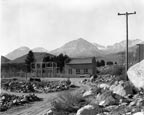 Barcode:
Barcode:1000481 |
Title: Owens Valley Power Plants
Description: Big Pine Power Plant 3 September, 1925 – “This is an ideal location for the Upper Plant; right over there we can located the intake for Plant No. 2 which will be farther down the canyon and that will locate Plant No. 3 in the delta just below the mouth of the canyon.” They were talking about the proper development of Big Pine Creek. The time was the summer of 1911. They were camped at the Forks of Big Pine Creek on the steep eastern slopes of the High Sierras. Above them towered the Sierras peaks 14,000 feet high – just below the crests were the snow and ice packs that give this section its renown for everlasting glaciers and constant water flow. The vision which prompted their decision was no doubt fathered by the realization that there was a close relationship between those towering peaks, the valley below, and the City of the Angels, 275 miles to the southward. Their vision included not only the proper development of power but the maximum use of the waters of the stream on the farms below; and their constant efforts and negotiations finally resulted in an agreement between the City and the Big Bear Water Users’ Association. An agreement of mutual benefit. The City was given the right to store water, provided it built the dams, and a schedule of water flow for each month was agreed upon. Built Dam at Lake No. 3 During the summer of 1921 a dam was partly built at Lake No. 2 and certain required storage thereby provided. The portion of the road built this summer of 1925, during the construction of Big Pine No. 3, looks forward to the ultimate raising of the level of the lakes and at the same time make that wonderful country accessible to the motorist. Big Pine No. 3 is now a reality. The mountains and the City have come closer together as a result of the completion of this project. This hydro-electric power is now flowing to the homes, farms and commercial centers of Owens Valley, where it renders a t cheap rates a service that is indispensable. More than that, – this power is adding in a big way to the water conservation and water development of Owens Valley directly – and the City of Los Angeles indirectly. It is the largest of six power plants on the 200-mile electric system which the City of Los Angeles owns and operates in Owens Valley. It is of especial interest that just at the time the plant was nearing completion, Mother Nature, through the vagaries of some record breaking storms, seriously crippled the Southern Sierras Power Company’s equipment that supplies some large chemical industries in the Valley, and through temporary connections Big Pine No. 3 Power Plant was able to step into the threatened power shortage and tide the Power Company over until repairs could be made. Big Pine No. 3 Power Plant is equipped with a 4,000-horsepower Pelton Water Wheel and a 4,000 K.V.A General Electric Generator which feeds into the 33,000-volt valley electric system of the Water Department through an outdoor step-up transformer station. Every possible provision has been made for the safety of men and equipment. In this power plant, whose intake is nearly a mile and a half above sea level, lightning is a nightly and almost daily visitor. The possibility of damage or interruption from this source was given special thought by the installation of the newest type of Auto Valve Lightning Arresters of the outdoor type. As much of the equipment as possible was installed outdoors and presents a pleasing part of the entire power plant setting. The building is of simple yet attractive design, reinforced concrete and fireproof in its construction, and withal it reflects credit to that first conception of location as well as to the more recent details of its construction. From the diversion dam or intake on the creek far up in the canyon, through the fish trap and the long pre-cast concrete flow line, to the steel penstock where the water shoots down more than 1,200 feet to the Power Plant, one can see every kind of difficult construction problem that can be imagined. This more then two miles of flow line and penstock was carved out of the steep mountain side under extreme difficulties. Careful preparation of construction equipment and the necessary provisions for making repairs or alterations in the field are largely responsible for the excellent showing made in completing the entire construction program within the scheduled time estimated. Too much credit cannot be given to the field forces for combating the various and sundry difficulties which are always present upon construction work. In this case, it was a race against time with the base of supplies 275 miles away and the fact added to the individual responsibilities of the men on the job. It is also to their credit that much of the work was done for less money than estimated and in some instances represented large savings over a contractor’s bid for doing the same work. At times, more than 200 men were employed, and the health of the various camps was 100 per cent, which speaks well for the cooks and the camp supervision. In carrying on the construction activities, every opportunity was given for the employment of Owens Valley residents and the few who went up from the city of Los Angeles were outspoken in their commendation of the interest displayed and the cordial treatment they received from their newly made friends in the Big Pine section. Many miles of excellent roads were built by the Department before the actual power plant construction could be started. These roads are already carrying a constantly increasing travel of autos into the glacier country at the head of Big Pine Creek. Big trees, waterfalls, beautiful lakes and permanent glaciers offer opportunity for fishing and sight-seeing which is unsurpassed in the West. The time is sure to come when this magnificent mountain country will be on the regular schedule of the traveling and camping public and when it does come, the Department of Water and Power will be given due credit for the constructive vision of its engineers in conserving and utilizing to best advantage so large a part of the natural resources on the Eastern Slope of the Sierra Nevada Mountains. Millions upon million of dollars is being spent in constructive activities in Owens Valley by the City of Los Angeles. The program of development is but started. “Rome was not built in a day.” The West was not won in a year nor a generation. As time goes by, and the far seeing vision of our leaders becomes reality, as has Big Pine No. 3, this southwest empire, from the High Sierras to the Pacific, will be one and the same family in thought, purpose and action. Subjects: Mountains Roads Electrical Apparatus Buildings Collection: Bledsoe Collection 1908-1933 |
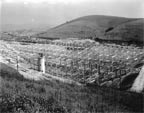 Barcode:
Barcode:1000731 |
Title: Ascot Reservoir
Description: Roof construction, Ascot Reservoir Subjects: Hills Electrical Apparatus Collection: Padilla Collection 1908-1935 |
 Barcode:
Barcode:1000847 |
Title: Pumping Plants
Photo Date: April 1933 Description:Maclay Pumping Plant Dependability of water service to the area in the western section of San Fernando Valley served by the Maclay reservoir is strengthened further by the recent installation of a battery of pumps at Upper San Fernando reservoir. Largest of their kind in the local water system, the pumps are described by S. M. Dunn, assistant to Fred J. Fisher, engineer in charge of pumping plants and reservoirs, as being 12-inch, 250 horsepower, and deep well turbine type. They are set in a common pit approximately 40 feet deep, and have a capacity of 15 second feet against a head of 325 feet. The pumping plant is located just below the San Fernando power plant along the penstock by-pass line. In the event of a protracted shutdown of the main aqueduct, water from the reservoir would be pumped back through the penstock to its connecting point with the branch line supplying Maclay reservoir. Paul J. Stoakin, in charge of all electric pumping plants under Fischer, said that the pumps are kept primed when the reservoir level is down by a vacuum pump located in the switch house. Although the plant is at the edge of Upper San Fernando reservoir, it will be known as Maclay pumping plant because its function is to supply Maclay reservoir when necessary. Fred Martin, operator of nearby Mission Wells pumping plant, will be in charge of the new plant also. Subjects: Hills Electrical Apparatus Collection: Padilla Collection 1908-1935 |
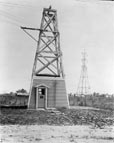 Barcode:
Barcode:1000862 |
Title: DWP Wells
Description: LADWP Well No. 11 Subjects: Wells Electrical Apparatus Collection: Padilla Collection 1908-1935 |
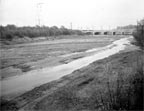 Barcode:
Barcode:1000864 |
Title: Los Angeles River
Description: Los Angeles River Los Angeles River, the unpredictable! She has changed her name, often has she changed her course, and many times has she changed the topography of the land she flows through. The first mention of our river by the white man is found in Fray Juan Crespi’s diary under the date of August 2, 1769. Fray Crespi was the diarist for the famed Portolá expedition that left San Diego, the first white settlement in California, July 14, 1769. The expedition wended its way north by land to establish a settlement upon Viscaino’s Bay of Monterey, discovered but not settled 160 years previously. Nor did Portolá settle or find Monterey Bay, but went past its latitude to become the discover of San Francisco Bay. After a weary march north from San Diego, Don Gaspar de Portolá’s party, consisting of 64 men, which included 27 leather-jacketed soldiers (soldados de cuera) under Rivera y Moncada, and six Catalan volunteers under Pedro Fages, with the Franciscan Father Crespi to record events, arrived on August 1 in the Arroyo Seco, about where Sycamore Grove is today. There they camped for the night. The following morning, the march had resumed for about a league and a half when they came upon a beautiful river, where, due to its being August 2, the day for the great Indulgence of Our Lady of Los Angeles de Porciúncula, they stopped for the day that every man might receive the Atomement, and named the river Porciúncula. This was out Los Angeles River, and the spot they camped on was about where Broadway crossed the river today. Since the entry in Fray Crespi’s diary is descriptive as well as highly prophetic, a quotation of the day’s entry is merited, as it is the first description ever given of the river or of the Los Angeles district: Wednesday, August 2, 1769. We set out from the valley in the morning and followed the same plain in a westerly direction. After traveling about a league and a half through a pass between low hills, we entered a very spacious valley, well grown with cottonwoods and alders, among which ran a beautiful river from north northwest, and then doubling the point of the steep hill, it went on afterwards to the south. Towards the north northeast there is another river bed which forms a spacious water course, but we found it dry. (Arroyo Seco) This bed unites with that of the river, giving clear indication of great floods in the rainy season, for we saw that it had many trunks of trees on the banks. We halted not very far from the river, which we named Porciúncula. Here we felt three consecutive earthquakes in the afternoon and night. We must have traveled about three leagues today. This plan where the river runs is very extensive. It has good land for planting all kinds of grain and seeds, and it’s the most suitable site of all we have seen for a mission, for it has all the requisites for a large settlement. Little did he realize how “large” a “settlement” would one day be here. But he continues: August 3. At half past six we left the camp and followed the Porciúncula River which runs down the valley, flowing through it from the mountains into the plain. After crossing the river we entered a large vineyard of wild grapes and infinity of rose bushes in full bloom. Fray Crespi’s report was undoubtedly the reason for the founding of the Pueblo de Nuestra Senora la Reina de Los Angeles, 12 year later, on the Rio Porciúncula, September 4, 1781. The first settlers immediately tapped the river with the Zanja Madre, and from that day on white men watched the moods of the Los Angeles River, wondering what new quirk she would take, and when. According to the early Spanish records, our river behaved herself pretty well for the first 30 years or more of the life of the town. Through rains were often heavy, the growth of willow thickets in the river bottom from well into San Fernando Valley down to and beyond the lower limits of the pueblo tended to check its flow short of flood proportions. The year 1815, however, was one never to be forgotten in the pueblo for, due to the heavy and continuous rains (it rained for 10 days and 10 nights without intermission), the river overflowed and changed its bed. The river moved over nearer the Plaza, running along the present North Spring Street (old San Fernando Street) to Alameda and down that thoroughfare to about First and Los Angeles Streets, down Los Angeles to Ninth Street, then west to Figueroa and down Figueroa and over to the ocean, where Playa del Ray is now located. The Plaza was flooded to a depth of several inches, and the old Indian village of Yang Na that had stood for centuries was a sea of floating wickiups. This flood not only changed the course of the river but also changed the location of the Plaza, which then stood about a block and a half northwest of the present Plaza. Governor Sola, in 1818, selected a location on higher ground and the Plaza was moved to its present site. Another great flood in 1825 carried the Rio de Los Angeles back to its present bed and changed its outlet to the sea from its old course through the Ballena Rancho, or Ballona as it was more commonly called, to its present course into the bay at Wilmington. This flood drained the marshlands between the pueblo and San Pedro, and caused the forests of sycamores and oaks, then growing abundantly, to disappear. Besides cutting a definite channel to tidewater, the flood caused a union of our river with the San Gabriel River, just north of Cerritos Rancho, and they flowed together into San Pedro Bay until 1867, when the San Gabriel formed a new channel into Alamitos Bay. In 1832, floods changed the drainage around the Compton district and dried up the few remaining lagoons. From then until the American occupation, the Los Angeles River behaved itself pretty well. Subjects: Water Bridges Electrical Apparatus Collection: Padilla Collection 1908-1935 |
